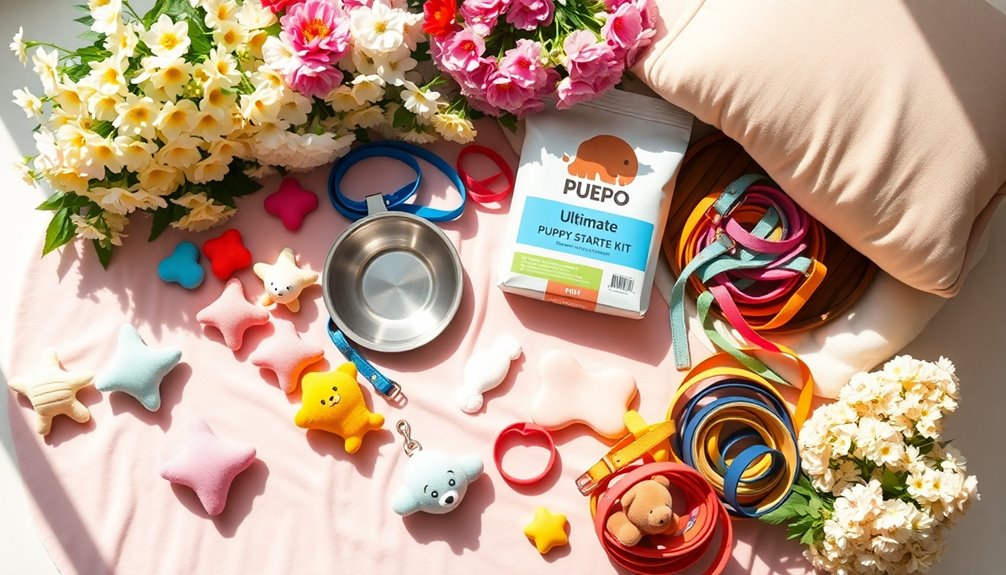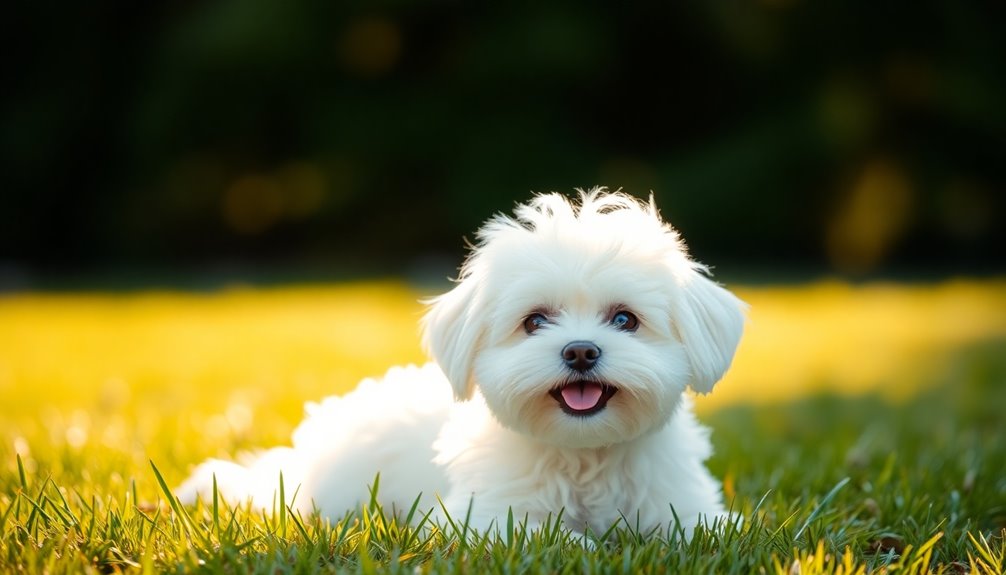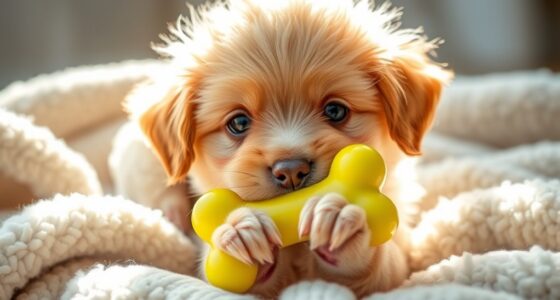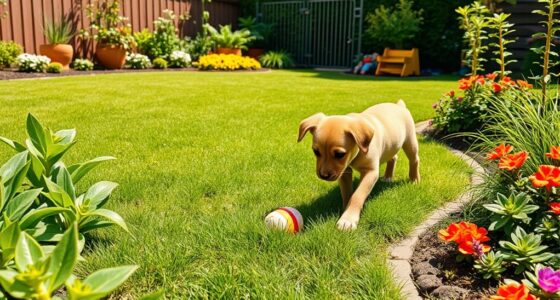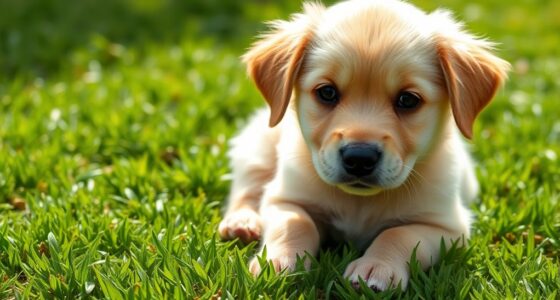To create the ultimate puppy starter kit, you need several key supplies. Start with high-quality puppy food and water bowls that are easy to clean. A durable crate and pads guarantee safe, comfortable containment. Don't forget a collar, leash, and ID tags for walking and safety. Chew toys are essential for teething, while grooming tools, like brushes and shampoo, keep your puppy clean. You'll also want cleaning supplies for accidents and a plan for health documentation. With all this, your puppy will feel right at home. If you want to verify nothing's overlooked, there's a bit more to contemplate.
Key Takeaways
- Provide high-quality puppy food and establish a feeding schedule to support growth and development during the early stages of life.
- Invest in a crate and pads for crate training, ensuring comfort and safety while promoting positive associations with the space.
- Equip your puppy with a lightweight adjustable collar and a standard 6-foot leash for safe walks and identification.
- Stock up on age-appropriate toys and grooming essentials to promote mental stimulation, dental health, and overall well-being.
- Build a support network including veterinarians, trainers, and groomers to ensure comprehensive care and training for your puppy.
Essential Supplies for Puppy Care

When you bring a puppy into your home, it's essential to stock up on necessary supplies that support their growth and development.
Start with high-quality puppy food tailored to meet their nutritional needs. Puppies aged 6-12 weeks require four meals a day, so be sure to have durable, non-slip stainless steel food and water bowls ready.
Chew toys are another important item; choose those free of artificial ingredients to promote healthy chewing habits.
Crate training is imperative for your puppy's safety and comfort, so invest in a crate that allows them to stand, turn, and stretch. A comfy crate pad will make it a cozy space for them.
Potty training pads are indispensable for housetraining, ensuring your puppy has a designated area for relief and minimizing indoor accidents.
Don't forget about veterinary care! Regular check-ups, vaccinations, and parasite prevention are crucial for maintaining your puppy's health.
Finally, keep training treats handy to reward good behavior and facilitate training. With these essential supplies, you're well on your way to providing a loving and nurturing environment for your new furry friend.
Nutrition and Feeding Guidelines
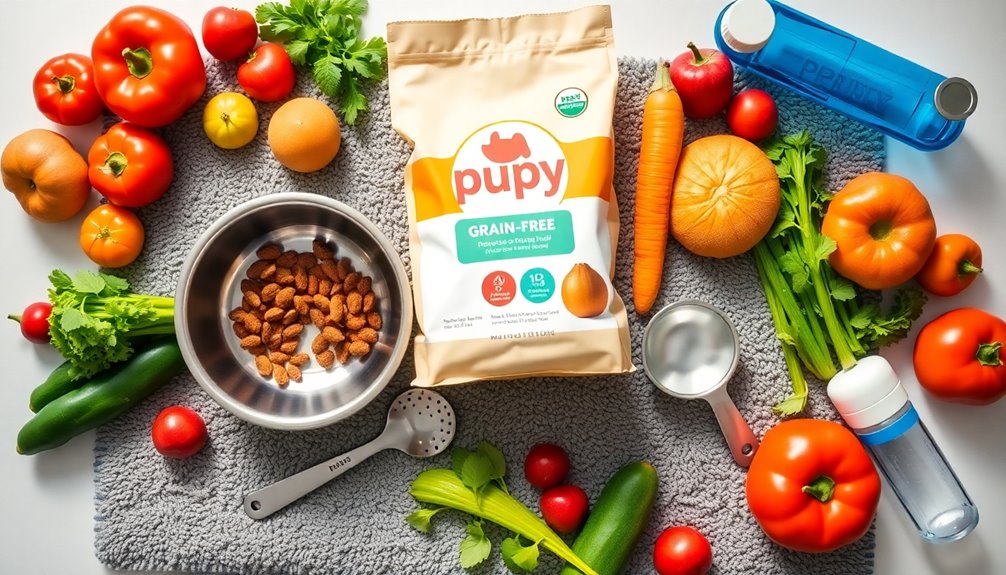
Providing your puppy with the right nutrition is key to their growth and overall health. Start with a high-quality puppy diet that meets their specific nutrition needs, which can vary by breed and age.
According to the American Kennel Club, feed your puppy four times a day from 6 to 12 weeks, three times daily from 3 to 6 months, and twice a day after 6 months.
Before making any changes, consult your breeder or shelter to find out what puppy food your furry friend is currently eating. When you're ready to switch to new food, do it gradually to avoid digestive issues.
Include chew treats and training treats that are free of artificial ingredients and support brain development. These not only help with positive reinforcement during training but also keep your puppy engaged and happy.
Lastly, make certain your puppy has access to fresh water at all times. Opt for non-tippable, easy-to-clean bowls to maintain hygiene and convenience.
Containment and Safety Gear

When it comes to your puppy's containment and safety, having the right crate and pad is essential for comfort and security.
You'll also want to evaluate travel kennel requirements to keep your furry friend safe on the go.
Let's explore what you need to create a secure environment for your new companion.
Crate and Pad Essentials
Many new puppy owners find that a crate and pad are fundamental for creating a safe and comfortable environment for their furry friend. The right-sized crate allows your puppy to stand, turn, and stretch comfortably, promoting safety and comfort. A crate pad adds a warm surface for resting, enhancing your puppy's overall well-being.
As you begin crate training, it's important to gradually introduce the crate, using treats and positive reinforcement to build a positive association with this new space. Maintaining hygiene is also essential; regularly check the crate and pad for cleanliness to guarantee your puppy's health.
Here are a few key considerations for crate and pad essentials:
- Size Matters: Verify the crate is appropriately sized to prevent excess space, which can lead to accidents and anxiety.
- Comfort is Key: A quality crate pad is fundamental for warmth and comfort, making crate time more inviting.
- Encourage Exploration: Consider using playpens alongside the crate for supervised exploration while maintaining safety and containment.
With these essentials, you'll provide a nurturing environment for your puppy's growth and happiness.
Travel Kennel Requirements
Choosing the right travel kennel is vital for your puppy's safety and comfort during trips. A well-sized travel kennel allows your puppy to stand, turn around, and lie down comfortably without excess space that could lead to injury.
When selecting a kennel, consider these key features:
| Feature | Importance |
|---|---|
| Durable Materials | Guarantees the kennel withstands chewing and scratching. |
| Secure Latches | Keeps your puppy safe and secure during transport. |
| Ventilation | Provides adequate airflow to keep your puppy comfortable. |
Additionally, verify that your travel kennel meets airline regulations if you're flying. Most airlines have specific requirements regarding dimensions and safety features. A removable, easy-to-clean bottom tray is also important for maintaining hygiene during travel, making quick clean-ups a breeze.
Walking and Identification Tools
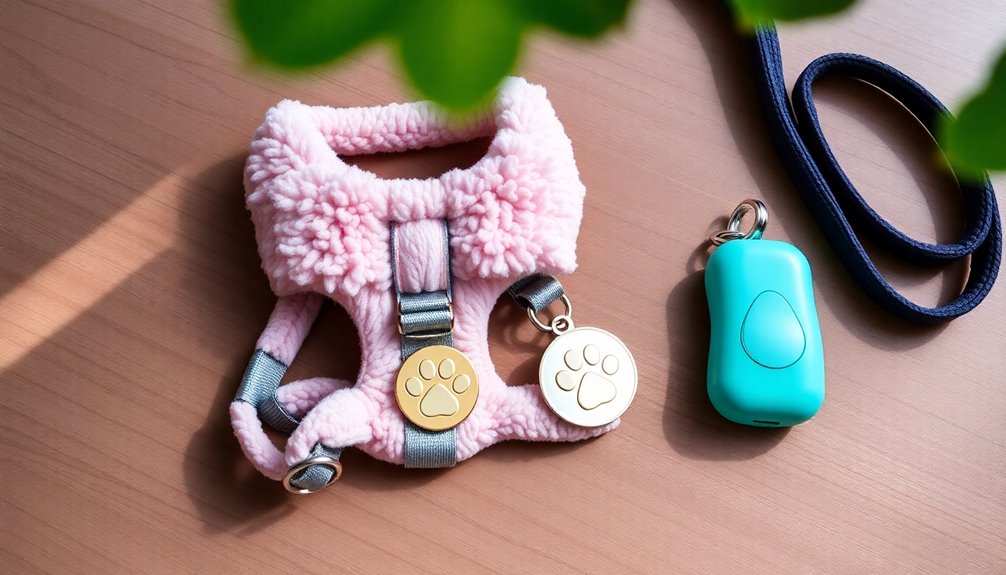
Before you take your puppy out for a walk, having the right walking and identification tools is fundamental. You want to guarantee your puppy's safety and comfort while also giving you control during training. Here's what you need:
- Collar: Choose a lightweight and adjustable collar that fits comfortably, allowing two fingers to slide underneath. It's essential for identification.
- Leash: A standard 6-foot nylon leash is ideal for training. It gives you control while allowing your puppy to explore safely.
- Harness: For better comfort and control, especially with small dogs or those prone to pulling, a harness can reduce neck strain during walks.
Don't forget identification tags! These are critical for reuniting with your puppy if they ever get lost. Make sure to include your contact information.
Regularly check your collar and leash for any wear and tear to keep your walks safe and effective. By investing in these tools, you're setting the foundation for enjoyable and safe outings with your puppy.
Toys for Play and Training
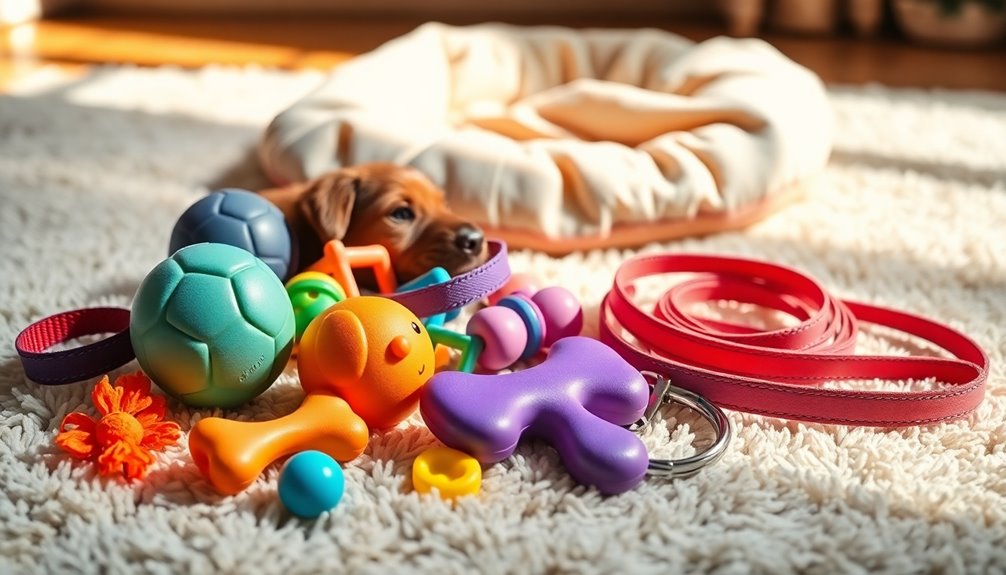
Choosing the right toys for your puppy is essential for both play and training.
Chew toys help with teething and curb destructive habits, while interactive options boost your bond and keep them mentally engaged.
Chew Toys Importance
Chew toys are a must-have for any puppy owner, as they play an essential role in your puppy's development and training. For teething puppies, these toys provide relief for sore gums while preventing destructive chewing behavior on your furniture and belongings.
Choosing the right chew toys promotes healthy chewing habits and helps develop strong teeth and gums.
When selecting chew toys, keep these key points in mind:
- Age-appropriate chew toys guarantee safety and engagement, preventing choking hazards.
- Interactive chew toys offer mental stimulation, which is critical for cognitive development and keeps your puppy entertained.
- Regularly rotating chew toys maintains your puppy's interest and prevents boredom, reducing the chance of destructive behaviors.
Interactive Play Options
Engaging your puppy in interactive play is a fantastic way to enhance their training and development. Interactive play toys, such as puzzle feeders and treat-dispensing toys, stimulate your puppy's mind and encourage problem-solving behavior, reducing boredom.
Rotating these toys every few days keeps your puppy interested while preventing them from feeling overwhelmed by too many options.
Choosing age-appropriate toys is essential for safety and engagement, ensuring they fit your puppy's chewing and play style. Chew toys not only satisfy your puppy's natural chewing instincts but also provide teething relief, helping to curb destructive behavior around your home.
Incorporating these toys into your playtime can foster bonding between you and your puppy while promoting physical activity and mental stimulation.
Age-Appropriate Selections
Finding the right toys for your puppy is vital to support their growth and prevent destructive behavior. Age-appropriate toys help satisfy their natural chewing instincts, especially during the teething phase between 3-6 months. Teething toys are important at this stage, while chew toys like those from Nylabone cater to different chewing stages and promote dental health.
Consider incorporating these types of toys into your puppy supplies:
- Teething toys: Alleviate discomfort during the teething phase.
- Interactive play toys: Foster bonding and provide energy release.
- Rotating toys: Keep your puppy engaged and stimulated.
Make certain to choose toys that are sized appropriately for your puppy's breed and age. This guarantees safety and enhances engagement, making playtime more effective for training and socialization.
Rotating toys regularly will help maintain your puppy's interest and keep boredom at bay. By providing a variety of textures and shapes, you'll stimulate their curiosity, making each play session both enjoyable and beneficial.
With the right toys, you'll set a solid foundation for your puppy's development and happiness.
Grooming and Hygiene Essentials
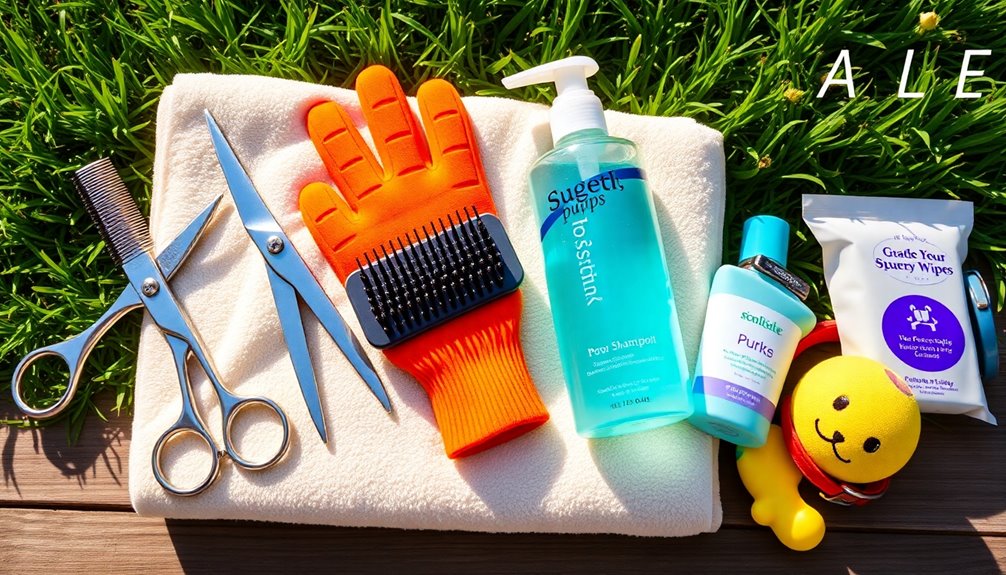
When bringing a puppy into your home, grooming and hygiene essentials are important for keeping your furry friend healthy and comfortable. A slicker brush is a must-have for all coat types, as it effectively removes tangles and mats while promoting bonding during grooming sessions.
Pair it with a gentle puppy shampoo specifically formulated for dogs' pH balance, guaranteeing a clean and healthy coat without irritation.
Regular nail clipping is essential for your puppy's paw health. Learn the proper technique to avoid discomfort and injury to the quick.
Don't forget about oral health! A dog toothbrush and toothpaste are crucial for establishing a dental routine that prevents plaque buildup and maintains overall oral health.
Keep pet wipes handy for quick clean-ups of your puppy's fur, especially after outdoor adventures or during travel.
These grooming and hygiene essentials not only enhance coat health but also contribute to your puppy's overall well-being. By incorporating these items into your routine, you'll make certain that your puppy feels comfortable, loved, and well-cared-for as they grow.
Cleaning and Potty Supplies
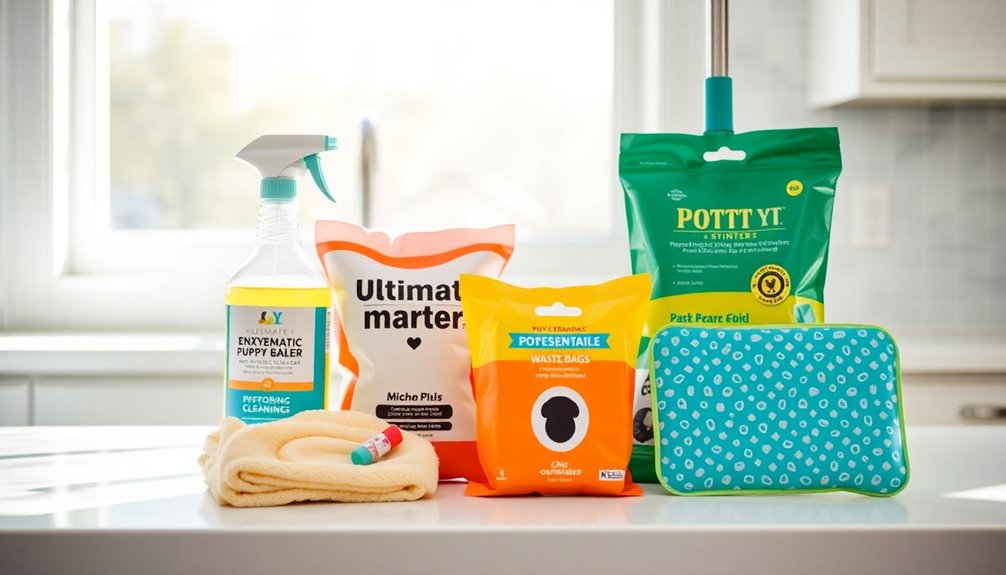
Cleaning and potty supplies are essential for keeping your home and your puppy in harmony. To create a hygienic environment and manage accidents effectively, you'll want to stock up on a few key items.
Puppy pads are vital for potty training, providing a designated spot for your pup to relieve themselves. Enzyme-based cleaners are a must-have since they neutralize odors and eliminate scents that might cause repeat accidents.
Here's a quick list of supplies you shouldn't overlook:
- Durable waste bags: Choose odor-locking options for responsible clean-up during walks.
- Poop bag holders: Clip these onto your leash for easy access whenever nature calls.
- Ammonia-free pet stain and odor remover: This helps you maintain cleanliness on surfaces without encouraging further soiling.
Documentation and Health Records
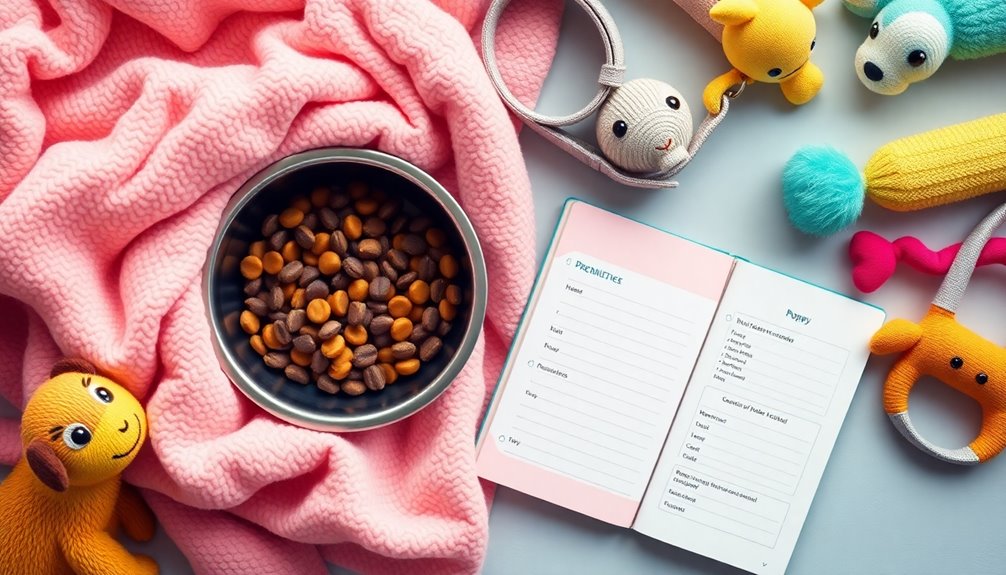
After ensuring your home is ready for your new puppy with the right cleaning and potty supplies, it's time to focus on their documentation and health records.
Microchipping is an essential step, providing a permanent identification method that can help reunite you with your puppy if they ever get lost.
You'll want to maintain accurate health records, tracking vaccinations and treatments for future vet visits, boarding, or travel.
Don't forget to register your puppy with local authorities, usually within 30 days of adoption, which typically involves a small fee.
Before your first vet visit, securing pet insurance is wise, as it can safeguard you against unexpected health issues.
Since younger pets often have more coverage options, act quickly.
Lastly, keeping records of training certificates demonstrates your commitment to responsible pet ownership.
These documents can be beneficial for behavioral assessments or when seeking care from sitters or boarding facilities. Additionally, early socialization with diverse dog breeds is crucial for your puppy's development and can help reduce fearfulness in new situations.
Building a Support Network
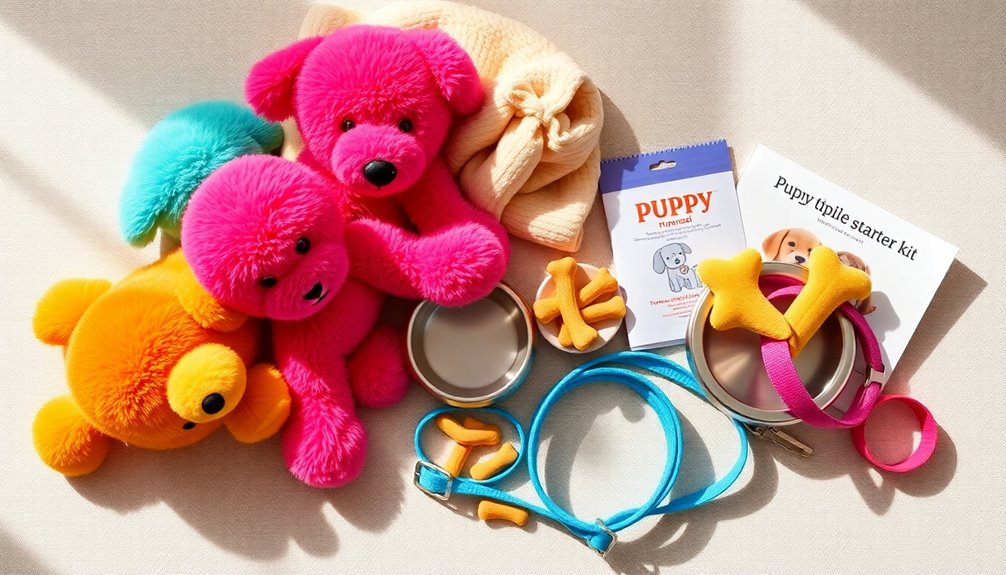
Creating a strong support network for your puppy is crucial for their well-being and your peace of mind. Building a support network involves connecting with trusted professionals and fellow pet owners who can enhance your puppy care journey.
Consider reaching out to:
- Veterinarians for health advice and regular check-ups.
- Trainers to help with obedience and socialization.
- Groomers who can keep your puppy looking and feeling great.
Engaging with local pet communities can provide you with beneficial insights and support. Other pet owners often have firsthand experiences and recommendations that can guide you in finding reliable pet sitters or walkers to manage your puppy's exercise needs, especially during busy days.
Regular communication with your network fosters a sense of community, making it easier to share experiences and tackle common puppy-related challenges. Additionally, understanding the importance of emotional resilience can help you cope with the challenges of puppy ownership.
Don't hesitate to ask for recommendations when searching for professionals. Finding qualified individuals who align with your pet care philosophy will give you confidence in the choices you're making for your puppy's health and happiness.
A solid support network is an important resource for managing the ups and downs of puppy ownership.
Frequently Asked Questions
What Should Be in a Puppy Starter Kit?
When you're putting together a puppy starter kit, you need to include high-quality puppy food that meets their nutritional needs.
Don't forget a durable crate and a cozy pad for comfort.
You should also have walking supplies like an adjustable collar, a 6-foot leash, and ID tags for safety.
Training essentials, including puppy pads and chew toys, are vital, along with grooming tools like a slicker brush and nail clippers to keep your puppy healthy.
What Is the Puppy 1/2 Rule?
Imagine your puppy's bladder is like a tiny balloon.
The Puppy 1/2 Rule states that for every month your puppy is old, they can hold their bladder for about an hour.
So, if you've got a two-month-old pup, expect them to need a bathroom break every two hours.
Sticking to this rule will help you create a consistent potty schedule, reducing accidents and easing the stress of house training for both you and your puppy.
What Are the First Things You Need for a Puppy?
When you get a puppy, you'll need some essential items right away.
Start with high-quality puppy food to support their growth and plan for feeding them four times a day. A comfortable crate and a sturdy water bowl are also crucial for their safety and hydration.
Don't forget identification tags and a proper collar to prevent loss.
Finally, grab some chew toys and basic grooming supplies like a brush and shampoo to keep them healthy.
Where Should Your Puppy Sleep the First Night?
Imagine bringing home a little golden retriever named Max. For his first night, you should create a safe, comfortable sleeping area for him.
Consider using a crate or a cozy dog bed in a quiet corner of your home. This space should be free from hazards, allowing Max to feel secure.
Gradually introduce him to his new bed with treats, making it a positive experience that helps him settle in and feel at home.
Conclusion
With the right supplies, you'll set your puppy up for a happy and healthy life. By prioritizing nutrition, ensuring safety, and providing engaging toys, you'll foster a loving environment. Keeping up with grooming, cleaning, and health records will make your journey smoother. Finally, building a support network of fellow pet owners and professionals will enrich your experience. So gather your essentials, embrace the joy, and watch your puppy thrive in their new home!

